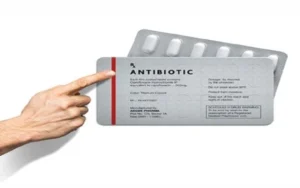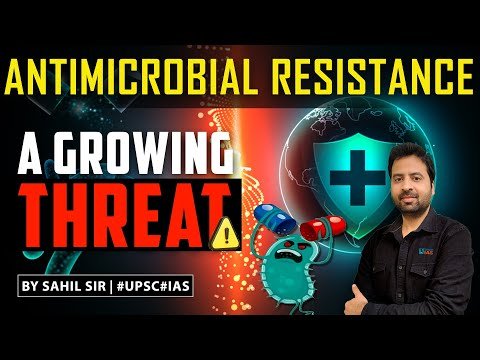Antimicrobial Resistance (AMR) and Priority Pathogens | UPSC
What is antimicrobial resistance?
- Antimicrobial resistance (AMR) or drug resistance, including antibiotic resistance, is a growing public health issue and needs urgent attention in countries around the world.
- Antimicrobial resistance (AMR) occurs when bacteria, viruses, fungi and parasites change over time and no longer respond to medicines making infections harder to treat and increasing the risk of disease spread, severe illness and death.
How does antimicrobial resistance develop?
- Natural variations in the genetic makeup of microbes cause resistance to develop against drugs over time as they reproduce.
- For example, alterations in their DNA could mean antimicrobials are no longer able to reach the microbe cell, or make microbes capable of creating enzymes which destroy the antimicrobial.
- Through natural selection these microbes with advantageous traits will proliferate over less-resistant strains, spreading the genetic advantage more widely.
- Microbes like bacteria are also able to directly transfer genetic material to each other in various ways other than reproduction.
- Although both of these ways of transferring genetic material occur naturally, poor use of antimicrobials, among other things, can speed up resistance developing and spreading.
- For example, if an antibiotic course does not totally kill off an infection we leave behind the microbes best able to fight against the drug. These will then multiply and pass on their survival traits.
- And the more we expose microbes to antimicrobials and/or other resistant microbes the more opportunities we create for resistance to develop and multiply.
Read also: Understanding Jet Streams: Formation, Types, Distribution, and Effects | UPSC
What are antimicrobials?
- Antimicrobials – including antibiotics, antivirals, antifungals and antiparasitics – are medicines used to prevent and treat infections in humans, animals and plants.
Why is antimicrobial resistance a global concern?
- The antimicrobial resistance threatens the ability of healthcare systems to treat common infections.
- Antibiotics are becoming increasingly ineffective as drug-resistance spreads globally leading to more difficult to treat infections and death.
- Rapid global spread of multi- and pan-resistant bacteria (also known as “superbugs”) cause infections that are not treatable with existing antimicrobial medicines such as antibiotics.
- WHO has declared that AMR is one of the top 10 global public health threats facing humanity in 2019 (Other 9 are: Air pollution and climate change, Non-communicable diseases, Global influenza pandemic, Fragile and vulnerable settings (drought, famine, conflict and population displacement), Ebola and other high-threat pathogens, Weak primary health care, Vaccine hesitancy. Vaccine hesitancy — the reluctance or refusal to vaccinate despite the availability of vaccines, Dengue, and HIV).
What are the causes of AMR?
- Overuse and misuse of antimicrobial medicines are major factors that have contributed to the development of drug-resistant microbes.
- In many places, antibiotics are overused and misused in people and animals, and often given without professional oversight.
- Examples of misuse include when they are taken by people with viral infections like colds and flu, and when they are given as growth promoters in animals or used to prevent diseases in healthy animals.
- Another major reason for the development of drug resistance is the lack of access to timely and appropriate treatments for infections, especially in Low and Middle-Income Countries (LMIC).
- Other important contributing factors to AMR include:
-
- inadequate infection control,
- substandard/falsified medicines and
- lack of access to affordable and appropriate diagnostics that give accurate and real-time results.
- lack of clean water and sanitation and hygiene (WASH) for both humans and animals.
What are some of India-specific causes?
- Some of the major factors which are contributing to the increasing incidences of anti-microbial resistance in India are:
- Mass bathing during cultural events;
- Excessive use of antibiotics in the livestock industry;
- Insufficient hospital hygiene;
- Misuse of antibiotics in humans and agriculture;
- Irresponsible manufacturing of antibiotics including uncontrolled discharge of effluents by the pharmaceutical industry;
- Lack of infrastructure and inadequate diagnostic facilities in our health-care sector is one of the major triggers of the irrational antibiotic use by doctors and the public.
What are priority pathogens?
- The six leading pathogens for deaths associated with anti-microbial resistance include Escherichia coli (E. coli), followed by, Staphylococcus aureus (S. aureus), Klebsiella pneumoniae (K. pneumonia), Streptococcus pneumoniae (S. pneumonia), Acinetobacter baumannii (A. baumannii) and Pseudomonas aeruginosa.
- Klebsiella pneumoniae are common intestinal bacteria that can cause life-threatening infections.
-
-
- K. pneumoniae is a major cause of hospital-acquired infections such as pneumonia, bloodstream infections, and infections in newborns and intensive-care unit patients.
-
- Drug-resistant Candida auris is one of the most common invasive fungal infections.
Steps taken to control anti-microbial resistance
a) Global Action Plan on AMR
- Inter-country development agencies (WHO, FAO, and World Organisation for Animal Health) developed a Global Action Plan on AMR.
- The global action plan outlines five strategic objectives for member states:
-
- Improve awareness and understanding of AMR through effective communication, education and training
- Strengthen the knowledge and evidence base through surveillance and research
- Reduce the incidence of infection through effective sanitation, hygiene and infection prevention measures
- Optimise the use of antimicrobial medicines in human and animal use
- Ensure sustainable investment in countering AMR
- India has developed its National Action Plan on AMR (NAP) in 2017.
- It is based on the One Health approach, which means that human health, animal health and the environment sectors have equal responsibilities and strategic actions in combating AMR.
b) National Action Plan on Anti-Microbial Resistance (NAP-AMR)
- A Core Working Group under the Ministry of Health and Family Welfare has drafted India’s own National Action Plan on Antimicrobial Resistance (NAP-AMR).
- NAP-AMR is based on the One Health approach, which means that human health, animal health and the environment sectors have equal responsibilities and strategic actions in combating AMR.
- The NAP-AMR outlines the priorities and interventions planned to be implemented over 2017 – 2021 to tackle the public health challenge of AMR in India.
- The first 5 strategic priorities of NAP-AMR are aligned with the Global Action Plan on AMR (GAP-AMR).
- India has a sixth priority that is India-specific dealing with strengthening India’s leadership on AMR – including international, national and sub-national collaborations on AMR.
c) Access, Watch and Reserve Category of Drugs: WHO
- In an effort to curb antibiotic resistance, the World Health Organization (WHO) has divided the drugs into three categories — access, watch and reserve — specifying which are to be used for common ailments and which are to be kept for complicated diseases.
- Access: Commonly used antibiotics will be under the ‘access’ category.
- Watch: The second line of antibiotics, slightly more potent, have been categorised under “watch”.
- Reserve: Potent drugs to be used only as a “last resort” fall under the ‘reserve’ category.
d) Global Antimicrobial Resistance and Use Surveillance System (GLASS)
- WHO launched the Global Antimicrobial Resistance and Use Surveillance System (GLASS) in 2015 to continue filling knowledge gaps and to inform strategies at all levels.
e) Red Line Campaign

- India’s Red Line campaign involves marking prescription-only antibiotics with a red line to curb their irrational use and create awareness on the dangers of taking antibiotics without being prescribed.
f) Chennai Declaration
- The Chennai Declaration is a document, prepared by representatives of various stakeholders and eminent experts in India, to tackle the challenge of anti-microbial resistance from an Indian perspective.
g) India’s first National Antimicrobial Resistance Hub in Kolkata
- The Indian Council of Medical Research (ICMR) inaugurated India’s first National Antimicrobial Resistance Hub in Kolkata.
- It would be the hub for research on antibiotic resistance not only for the country but for the entire South Asia.
h) World Antimicrobial Awareness Week
- World Antimicrobial Awareness Week is held every year from November 18-24 to spread awareness on this issue.
Read also: Heatwaves: Causes, Effects, Prediction, Mitigation | UPSC
Miscellaneous
a) What are Superbugs?
- It is a term used to describe strains of bacteria that are resistant to the majority of antibiotics commonly used today.
b) Indian Network for Fishery and Animal Antimicrobial Resistance (INFAAR)
- The Indian Network for Fishery and Animal Antimicrobial Resistance (INFAAR) is a network of laboratories established under the Indian Council of Agricultural Research (ICAR), along with technical support from the Food and Agriculture Organization of the United Nations (FAO) and the United States Agency for International Development (USAID), is dedicated to AMR surveillance in fisheries and livestock sectors.
c) Triclosan and antibiotic resistance
- Triclosan, a compound used in more than 2,000 personal care products, and a common ingredient found in toothpastes and hand washes could be contributing to the rise of antibiotic resistant bacteria, a study has found.
References:
- https://ncdc.gov.in/WriteReadData/l892s/File645.pdf
- https://www.who.int/news-room/fact-sheets/detail/antimicrobial-resistance
- https://www.gavi.org/vaccineswork/what-antimicrobial-resistance-and-how-can-we-tackle-it?gad_source=1&gclid=CjwKCAjwwr6wBhBcEiwAfMEQs_Wds_altfLVwC9_6JfO164gnBnd64hDCbRH0heHQZOjbyKTmFzU4BoCy2AQAvD_BwE
- https://ncdc.gov.in/WriteReadData/l892s/File645.pdf
- https://www.uicc.org/what-we-do/thematic-areas/antimicrobial-resistance-amr?gad_source=1&gclid=CjwKCAjwwr6wBhBcEiwAfMEQsxJnQTCTSuU3MI9mbDU3qMGZRJV6DsVIi97x0aCKJc7YqzPXkD56TBoCBIIQAvD_BwE#49322
- https://www.who.int/news-room/fact-sheets/detail/antimicrobial-resistance
- https://www.thehindu.com/opinion/editorial/drug-war-on-use-of-antibiotics-and-antimicrobial-resistance/article67710044.ece
- https://www.downtoearth.org.in/news/food/fao-publishes-first-national-report-on-amr-surveillance-in-india-s-fisheries-livestock-sectors-94931
- https://pib.gov.in/PressReleasePage.aspx?PRID=1848805
Practice Questions:
Q . With reference to antimicrobial resistance (AMR), consider the following statements:
- Antimicrobial resistance occurs when microorganisms develop the ability to withstand the effects of antimicrobial drugs designed to kill them.
- Misuse and overuse of antimicrobial drugs accelerate the development of antimicrobial resistance.
- Antimicrobial resistance is only a concern in bacterial infections and has no relevance to viral infections.
How many of the above statements are correct?
(a) Only one
(b) Only two
(c) All three
(d) None
Answer: b
Explanation:
- Antimicrobial resistance (AMR) refers to the ability of microorganisms such as bacteria, viruses, fungi, and parasites to resist the effects of antimicrobial drugs. Hence, Statement 1 is correct.
- This resistance occurs when these microorganisms mutate or evolve in such a way that the drugs become ineffective against them.
- Misuse and overuse of antimicrobial drugs are significant drivers of antimicrobial resistance. Hence, Statement 2 is correct.
-
- When antimicrobial drugs are used unnecessarily, for incorrect durations, or in inappropriate dosages, it can promote the development of resistant strains of microorganisms.
- While antimicrobial resistance is commonly associated with bacterial infections, it is also relevant to other types of infections, including viral infections. Hence, Statement 3 is not correct.
-
- For example, the misuse of antiviral drugs can lead to the development of resistant strains of viruses such as HIV and influenza.
Hence, only two of the statements given above are correct.
Therefore, option (b) is the correct answer.
Relevance:
Subject: Current Affairs | Science and Technology
Tags: Factual | Easy Difficulty Level
Mains Answer Writing Practice
Topic: Science and Technology- Developments and their Applications and Effects in Everyday Life. (GS Mains Paper 3)
- What are the key factors contributing to antimicrobial resistance (AMR) in India, and how do they affect healthcare, agriculture, and the overall economy? Explore the strategies and challenges associated with combating AMR in the Indian context. (Answer in 250 words)


